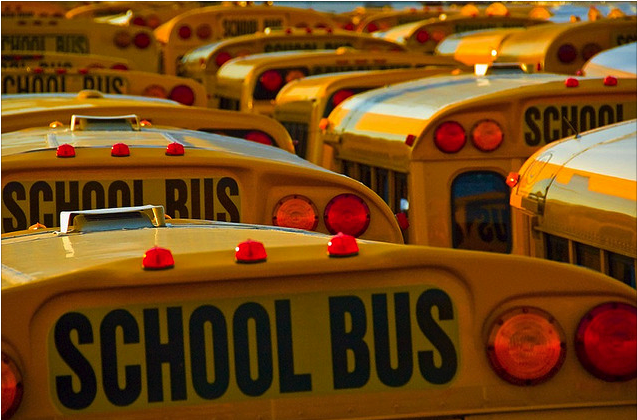Arbitrary School Suspensions On The Rise?

Without getting into the discussion of how technology is facilitating harsher disciplinary objectives, I would like to say that the length to which administrators are going to “do their job” is quite frankly, uncalled for. The things for which students are being suspended make school discipline departments seem like old Cops rerun addicts—chanting “what you gonna do when they come for you, bad boy, bad boy!”
But hey, if the TV show Cops decides to make a comeback, they can now shoot in schools as well! Law enforcement is now actively present on our school campuses, making more and more arrests. According to the Harvard Civil Rights Project, students accused of “disturbing schools” are now being referred to law enforcement. With the police sitting in our schools discipline offices, administrators can simply send students to the police. Just ask 12 year old Alexa Gonzales. In 2009, she was dragged out of school in handcuffs for drawing on her desk. A class action suit was filed last year against the city, and officials did acknowledge that “this shouldn’t have happened.” But it still does. So our kids mingle with the cops and the courts, before they meet colleges and scholarships. Great.
As for the 12-year-old child arrested, take no last name for granted. Alexa Gonzales is a brown student who like many of her peers, faces unsettling assumptions from her “educators.” According to the New York Civil Liberties Union (NYCLU), the best demographic indicators of children that are likely to be suspended, and hence likely to deal with the police, are not the type or severity of the offense, but the color of their skin, the school they go to, and whether they have been suspended before. So when lashing out the strikes of discipline, the whip of law enforcement reaches the students of color on the front lines. Children are being punished for circumstances beyond their control.
Of course I am appalled. Kids who are suspended are more likely to fall behind in school, drop out of high school, commit a crime, and become incarcerated as adults, says the NYCLU. In fact, the Defenders Online Source reported school suspension as the top predictor for students incarcerated by ninth grade. Suspension is not the answer. Do parents kick their kids out for messing up? I would hope not.
The problem is that for most educators, these are not their kids, but they should be. Before I go on, I would like to establish that the purpose of this piece is not to bash on schools and teachers, but rather see them as with potential, just as they should see all of their students. Jeffrey Duncan Andrade, P.H.D, a leading voice in urban education, published “Note to Educators: Hope Required When Growing Roses in Concrete” in the Harvard Educational Review. “We cannot treat our students as “other people’s children” –their pain is our pain,” he says. We have the potential of truly being there for our students. We just can’t tell our kids we feel their pain, sometimes. He correctly identifies a flaw in our culture that prizes individualized notions of success, where I, is all that matters. Instead we need to embrace collective values by struggling alongside one another. One word: solidarity.
Andrade’s article should be read by all educators – and anyone interested in the human race. It outlines prescriptions that I believe are solutions to issues of aggressive discipline and the achievement gap in our schools. We need to foster relationships of interdependency. One teacher humanized his students by asking them to tell their stories, thus creating solidarity and humanization amongst them. As one student said, “It was beautiful…my classmate…is fighting the same fight that I am fighting. So, I got his back.” Teachers and students alike should have each other’s back.
And maybe a little bit more. A teacher herself has potential to be a “material resource” to her students. The most cited student experiences with influential educators describe people that are indispensable in their lives. The teacher that stays the extra minute to help her students, gives that ride home, sends infinite messages, phone calls, and emails, and overall exerts the maximum amount of positive influence, will make a difference. Those efforts and sacrifices of teachers are felt by students who will more willingly learn. Andrade supports this with numerous studies and the proverb, “students don’t care what you know, until they know that you care.” Who would of thought, caring does go a long way! Don’t get me wrong, I am in college today because teachers that truly care do exist. This piece is for those who have yet to exist.
If administrators felt connected to their students in these ways, I hardly believe they would continue to readily hand them over to the police. If student-teacher relationships were built on trust and shared understanding, throwing a student out of a classroom would take second thoughts. If you stand in someone else’s shoes, you will more likely make amends to their shoes.
But maybe I’m asking too much. Maybe I am too optimistic. Maybe I expect too much. Well, I am 100 percent sure that asking for more, optimism, and elevated expectations of our educators will bring change. Good change. In an era where budgets are deficits, and resources run thin, the heart should beat vigorously. Better yet, collectively. I as we, we as all, and all in all, the world can crawl along to a better place.
Best way to find more great content from Neon Tommy?
Or join our email list below to enjoy the weekly Neon Tommy News Highlights.



